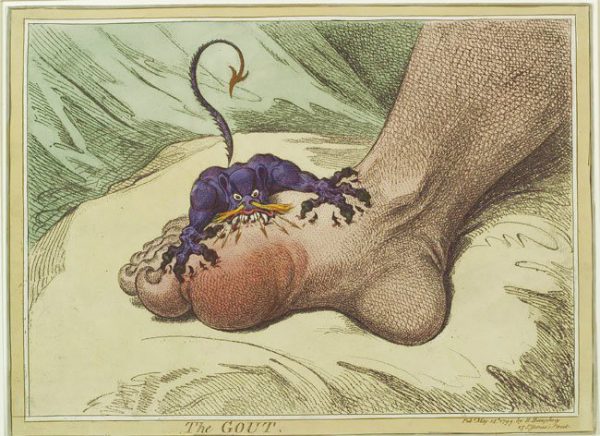Gout: Great Toe (Podagra)
Summary
The great toe is a common site for a gout attack. Gout is a painful disorder that is characterized by uric acid crystal deposits within the joint lining. Uric acid accumulates and forms crystals in joints when there are abnormally high levels of uric acid in the blood. These crystal deposits trigger an intense inflammatory response, leading to sudden “attacks” of marked pain and swelling in the affected joint. One of the most common joints where this occurs is at the base of the great toe (the 1st metatarsophalangeal joint). Over time repetitive gout attacks involving the great toe can lead to significant great toe arthritis.
Figure 1: “The Gout” by James Gilray 1799

Clinical Presentation
A painful great toe due to gout is often called “podagra.” Patients will present with pain, swelling, and redness at the base of the great toe during the gout “attacks.” Patients may have difficulty walking on the affected foot due to the intense pain. A diet high in red meat, seafood, and/or alcohol increases blood uric acid levels and thus increases the risk of gout. Therefore, a patient’s history may reveal recent consumption of these substances.
Physical Examination
Physical exam in patients with gout involving the big toe will usually have pain and swelling. The toe may be red and exquisitely tender to touch during a gout attack. In patients with a history of gouty attacks examination of the great toe may reveal the presence of tophi, which are lumps that are made up of collections of the gout crystals. Large crystal deposits may also be identified on ultrasound and X-ray. A diagnosis of gout is made using the patient’s history and may be confirmed by a procedure called an arthrocentesis. An arthrocentesis involves inserting a needle into the MTP joint to get a sample of the synovial fluid that is located in the joint cavity. This fluid can then be analyzed for signs of inflammation and the presence of uric acid crystals.
Treatment
Treatment of gout can be classified as acute/short-term and long-term. Treatment of an acute gout attack involving the great toe is focused on decreasing pain and inflammation. Anti-inflammatory medication such as indomethacin or ibuprofen are usually started provided the patient has no contra-indications to these medications. In some patients with intense symptoms it may be necessary to start a short course of a stronger anti-inflammatory such as the steroid methylprednisolone (brand name: Medrol). Limiting activity, elevating and icing the foot may also be helpful to decrease the initial pain and swelling of a great toe gout attack.
Long-term management of great toe gout includes medications that reduce the amount of uric acid in the blood and surgical removal of tophi. If the gout is a result of another chronic condition, such as kidney failure, then long term management would involve addressing these conditions.
Edited July 1, 2020